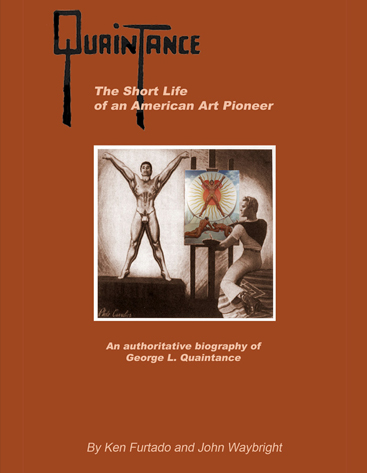- Details
- Written by: Ken Furtado
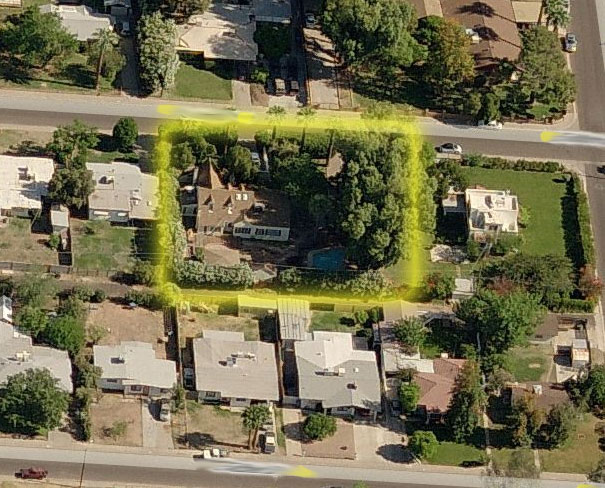 Rancho Siesta was many things. It was the Arizona studio where George Quaintance lived and worked. It was an ingenious and overwhelmingly successful marketing concept. And it was the closest the American West ever came to an honest-to-goodness incarnation of Shangri-La.
Rancho Siesta was many things. It was the Arizona studio where George Quaintance lived and worked. It was an ingenious and overwhelmingly successful marketing concept. And it was the closest the American West ever came to an honest-to-goodness incarnation of Shangri-La.
It's interesting that Disneyland opened in 1955, when Rancho Siesta was at the height of its fame and popularity. Disneyland offered Adventureland, Fantasyland, Tomorrowland and Frontierland. Rancho Siesta offered the same, but in a different package.
- Details
- Written by: Ken Furtado
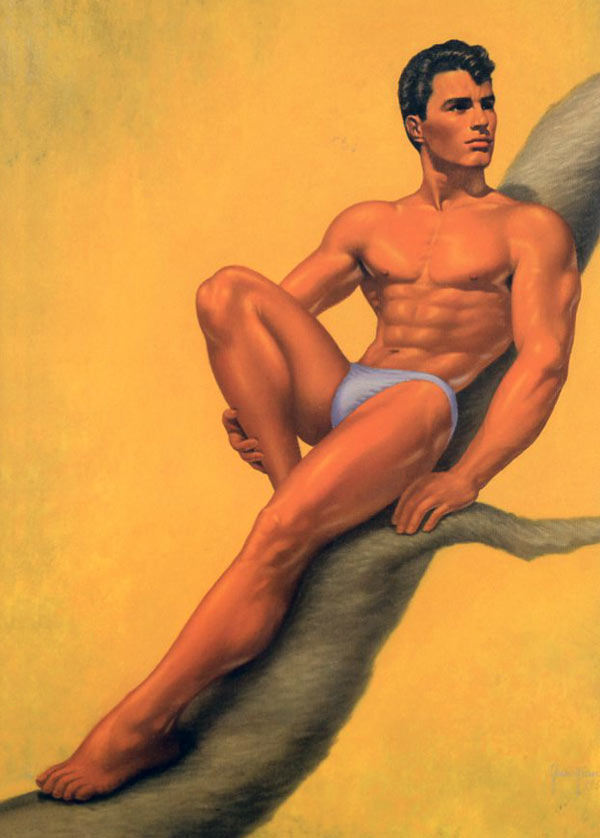 Glenn Bishop was a hugely popular physique model in the 1950s. There's hardly a single publication of that era that did not have his photos in it at one time or other. Bishop began modeling when he was 15. He was touted as an example of how teenagers could follow the bodybuilding examples of adults. Later, Joe Weider used Bishop as an example of how anyone could build a great physique by following a regimen of calisthenics and weightlifting with free weights — preferably, Weider equipment. No expensive gym membership necessary.
Glenn Bishop was a hugely popular physique model in the 1950s. There's hardly a single publication of that era that did not have his photos in it at one time or other. Bishop began modeling when he was 15. He was touted as an example of how teenagers could follow the bodybuilding examples of adults. Later, Joe Weider used Bishop as an example of how anyone could build a great physique by following a regimen of calisthenics and weightlifting with free weights — preferably, Weider equipment. No expensive gym membership necessary.
Quaintance painted Glenn Bishop's portrait in 1957, the year he (Quaintance) died. The 37x30-inch oil on canvas depicts Bishop, wearing a bikini, reclining along the trunk of a dead tree. The canvas is signed and dated in the lower right.
- Details
- Written by: Ken Furtado
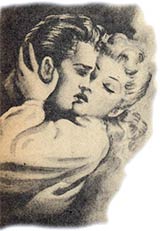 During the 1930s, George Quaintance made an international name for himself as a designer of women's hairstyles. His clients on both coasts were illustrious women of stage, screen, politics and high society. He was in great demand at beauty shows and conventions and one of his major sponsors was Procter and Gamble. In the winter of 1938 alone, Quaintance attended conventions and gave demonstrations in Atlanta, Boston, Detroit, Philadelphia, Chicago, Dallas and New York City. Quaintance was an early proponent of the theory that the design of a hairstyle must take into account the geometry of the face and hairline.
During the 1930s, George Quaintance made an international name for himself as a designer of women's hairstyles. His clients on both coasts were illustrious women of stage, screen, politics and high society. He was in great demand at beauty shows and conventions and one of his major sponsors was Procter and Gamble. In the winter of 1938 alone, Quaintance attended conventions and gave demonstrations in Atlanta, Boston, Detroit, Philadelphia, Chicago, Dallas and New York City. Quaintance was an early proponent of the theory that the design of a hairstyle must take into account the geometry of the face and hairline.
Although Quaintance designed more hairstyles than he actually executed, it is not true, as has been written elsewhere, that "he never actually touched hair." Contributing to his great appeal were shows in which he would not only design a hairstyle for a woman selected from the audience, but execute it on the spot for all in attendance to see.
- Details
- Written by: Ken Furtado
 In the 1930s, Quaintance seemed preoccupied with depicting disembodied heads. He did it in lithographs, on book dust jackets, in advertising imagery and, when that was not enough, he ventured into the third dimension. The result was a series of wall plaques in high relief that he collectively called masques, while giving individual titles to the various faces.
In the 1930s, Quaintance seemed preoccupied with depicting disembodied heads. He did it in lithographs, on book dust jackets, in advertising imagery and, when that was not enough, he ventured into the third dimension. The result was a series of wall plaques in high relief that he collectively called masques, while giving individual titles to the various faces.
- Details
- Written by: Ken Furtado
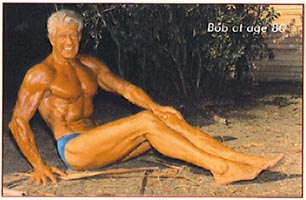 Bob Delmonteque has died. He passed away on Thanksgiving Day, Nov. 24, 2011 in Los Angeles. His age was reported as 85, which is a small fib, because when Bob reached 85, he remained 85 for the rest of his life. For his website, bobdelmonteque.com (still online as of this writing), Bob wrote a brief bio in which he says he was born Nov. 9, 1919, which would have made him 92. His given name was Mike Diaks.
Bob Delmonteque has died. He passed away on Thanksgiving Day, Nov. 24, 2011 in Los Angeles. His age was reported as 85, which is a small fib, because when Bob reached 85, he remained 85 for the rest of his life. For his website, bobdelmonteque.com (still online as of this writing), Bob wrote a brief bio in which he says he was born Nov. 9, 1919, which would have made him 92. His given name was Mike Diaks.
The online autobiography completely omits the part of Delmonteque's life that may be of greatest interest to readers here. After the end of WWII, Delmonteque became one of the great early male physique models. He was initially made famous by photographer Douglas of Detroit, whose photos of Delmonteque appeared in nearly every male fitness and physical culture magazine of the day — this at a time when frontal male nudity could land you in jail.
- Details
- Written by: Ken Furtado
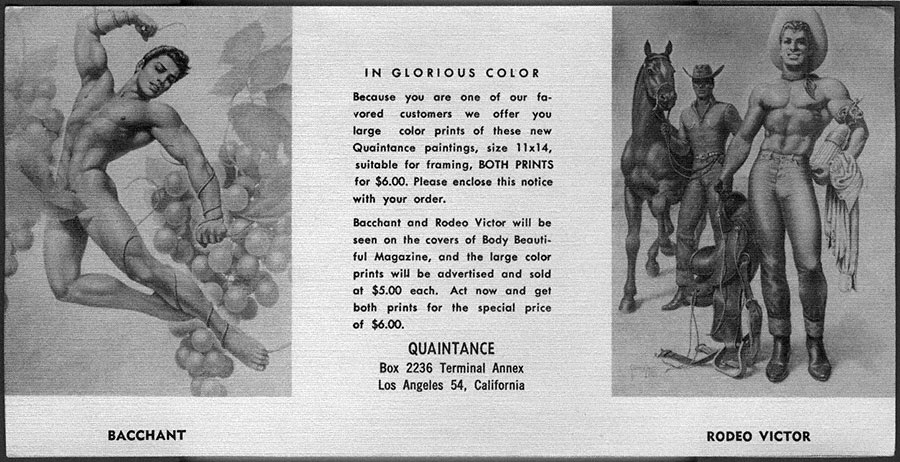 These final five lithographs were produced shortly before Quaintance's death. As a result, they were not heavily advertised nor were many sold, and they are quite difficult to find. Bacchant and Rodeo Victor were issued as a pair, and both images appeared on the covers of numerous magazines in the US and Europe. The size was 11x14 inches — the same as Baths of Ancient Rome and Spartan Soldiers Bathing — except the wide margins were omitted. The attached image shows an advertising insert Quaintance sent to his mail-order customers to announce this duo. (Pardon the seam on the color images, which I had to scan in two passes each.)
These final five lithographs were produced shortly before Quaintance's death. As a result, they were not heavily advertised nor were many sold, and they are quite difficult to find. Bacchant and Rodeo Victor were issued as a pair, and both images appeared on the covers of numerous magazines in the US and Europe. The size was 11x14 inches — the same as Baths of Ancient Rome and Spartan Soldiers Bathing — except the wide margins were omitted. The attached image shows an advertising insert Quaintance sent to his mail-order customers to announce this duo. (Pardon the seam on the color images, which I had to scan in two passes each.)

